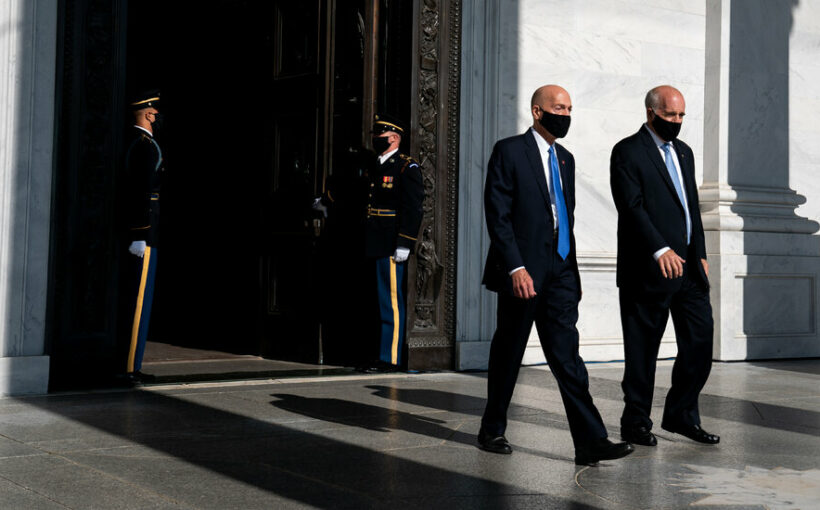Both men had similar backgrounds, working for years as Secret Service agents but considered more skilled in navigating the agency’s political infighting than as experts in protection. Both went on to land plum assignments: the sergeants-at-arms of the Senate and House.
Now, the two men, Michael C. Stenger and Paul D. Irving, have resigned from those posts and are facing intense scrutiny over the security failure last week that led to the deadly siege of the Capitol, its first occupation since the War of 1812. The former chief of the Capitol Police Steven Sund told The Washington Post that they refused to grant his requests to put the National Guard on standby leading up to Congress’s Electoral College certification, which Trump supporters ultimately disrupted, because they were too concerned about the “optics” of such a move.
The jobs forced both men to balance an array of often-conflicting forces, according to interviews with former colleagues, law enforcement experts and former sergeants-at-arms. Attempts to reach Mr. Stenger and Mr. Irving were unsuccessful.
The sergeant-at-arms posts are unique because they come with the responsibility of overseeing not only security but also protocol and the day-to-day operations of the Capitol, like arranging V.I.P. parking passes or even the printing of posters that lawmaker use as props for speeches.
“It’s an extremely prestigious job for a former law enforcement official — but it’s very unique as it has a very large mandate and the resources are thin,” said Rick Nelson, a former national security official under George W. Bush.
“The problem is that when you have such a wide mandate, your finger is always in a different dike, as one day you have a protocol issue, the next you’re dealing with something on cyber, and eventually you’re going to leave something uncovered because you’re going to run out of fingers,” he added. “From a security perspective, it makes it highly difficult.”
Both positions derive their power directly from lawmakers. The Senate elects its sergeant-at-arms and the speaker of the House picks that chamber’s. Mr. Stenger, who worked for the Senate, and Mr. Irving, his House counterpart, deftly tried to satisfy the 535 lawmakers who often had competing demands that made even mundane decisions like replacing locks on windows into fraught issues, according to interviews.
Mr. Irving was considered particularly astute at managing the politics of the Capitol as he pulled off a feat rarely accomplished by his predecessors: He remained in his role even though the House changing to Democratic control in 2018.
But the accusations by Mr. Sund, who had reported to both men, ignited criticisms that Mr. Stenger and Mr. Irving had placed politics over the safety of lawmakers, staff members and journalists assembled for the count of the Electoral College vote.
Lawmakers often held significant sway over how decisions about security were made, former law enforcement officials and a former sergeant-at-arms said.
Terrance W. Gainer, who previously served as both the chief of the Capitol Police and the Senate’s sergeant-at-arms, said that based on his experience, Capitol security officials often had to run their plans by members of Congress before major events. He said that given the blowback after the heavy policing of demonstrations against police brutality this summer, lawmakers were likely wary of allowing the Capitol to appear like a fortress.
“It wouldn’t surprise me, having been chief, if there was some reticence on behalf of leadership in the House and Senate not wanting to look like we were overarmed,” Mr. Gainer said.
Former Secret Service officials said that although Mr. Stenger and Mr. Irving were senior officials there in the years after the Sept. 11, 2001, attacks — when the federal government remade its security apparatus to defend against a range of threats — their time did little to equip them to deal with dynamic security issues like a siege.
Mr. Stenger did not hold a prominent Secret Service role in a security detail protecting a president or vice president, according to former agency officials. In one of his final posts at the agency, he led the Office of Protective Research, an intelligence division that investigates threats against the president.
Mr. Irving served in another role that had little to do with day-to-day security protection: the head of the Secret Service’s congressional liaison office. In that post, he built relationships with lawmakers and staff aides, answering their questions about the agency’s work and arranging testimony for top officials.
Mr. Gainer, the former sergeant-at-arms and head of the Capitol Police, said that emergencies on Capitol Hill typically exposed problems with the chain of command that had festered during quieter times. He said that during the 2013 shooting at the Washington Navy Yard and the 2011 earthquake on the East Coast, security officials on Capitol Hill had differing views on how to react, complicating their response.
Shaila Dewan contributed reporting.
Source: Read Full Article
